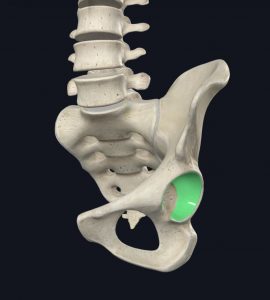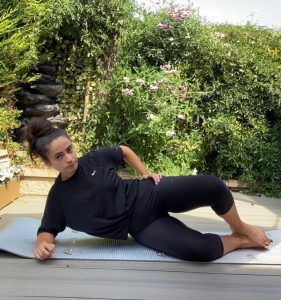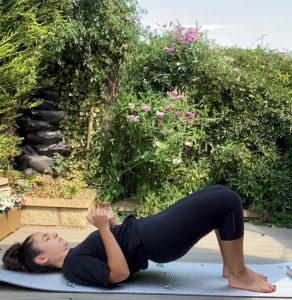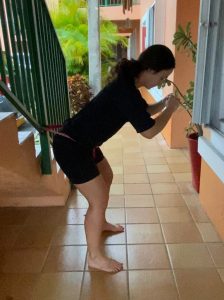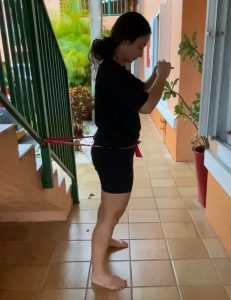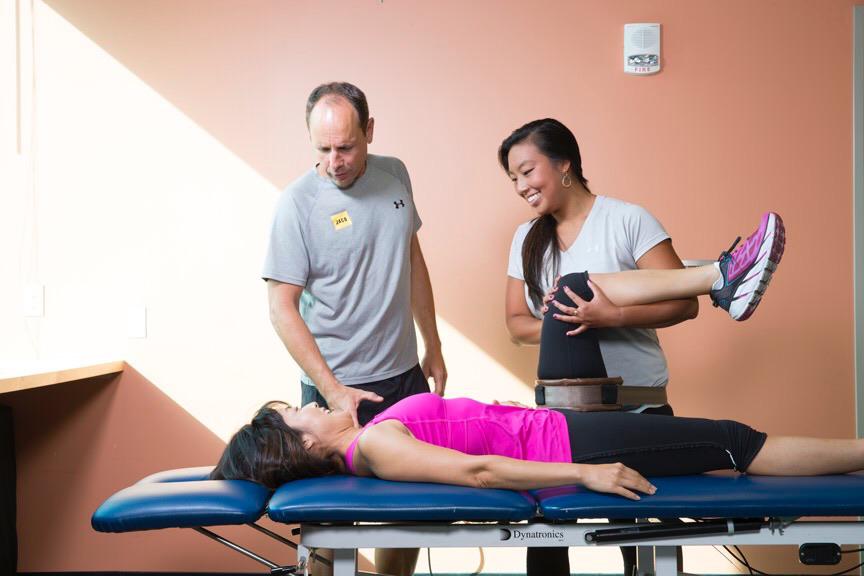
Have you been told that you have a labral tear in your hip?
Let’s learn about what a hip labral tear means for you, and how physical therapy treatment can address this injury with or without surgery.
It is important to understand the type of limitations associated so that you know what to expect. Luckily, physical therapy can help to address your limitations by improving range of motion, strength, and balance.
Build a greater understanding of your injury, which interventions to ask about, and get a head start in your rehabilitation. If you have any questions, reach out to us at JACO Rehab!
What is a Labrum?
The labrum is a circular ring of cartilage that lines the hip’s socket. Its main job is to assist with even load absorption through the joint during activity. The labrum also provides a vacuum-like seal to improve joint stability.
- The labrum of the hip (highlighted) | Image courtesy of Complete Anatomy
What is a Labral Tear of the Hip?
A labral tear is damage to the hip socket’s cartilage. Labral tears may occur due to advanced femoral acetabular impingement (FAI), wear and tear, or trauma. FAI occurs when the femoral head and the acetabulum are compressing on each other due to change in shape of the femur head.
When there is a tear in the labrum, the vacuum-like seal and shock absorption is compromised, leading to a more vulnerable hip joint. First symptoms usually present as pain along the groin and can refer down the thigh to the knee.
How Serious Are Labral Tears of the Hip?
Labral tears can range in severity depending on the location and size of the tear. Some tears aren’t don’t feel like anything, while others are painful with feelings of instability or a catching in the joint during activity.
A labral tear becomes more serious when pain limits mobility and strength, and compensations develop to keep you moving. Your body finds ways to move around the injury, leading to muscle disuse and stiffness. Muscle weakness and mobility limitations lead to limping, activity avoidance, and difficulty doing daily tasks.
If symptomatic and left untreated, a labral tear can become debilitating. But there are ways to manage it. Physical therapy can address many of these deficits without the need to jump into surgery immediately.
How to Address Hip Labral Tears Without Surgery
Physical therapists are trained to evaluate hip function with tests and measures to help differentiate the origin of hip pain. They are able to differentiate which area of the hip is involved by:
- Listening to your symptoms
- Examining any mobility and strength deficits
- Performing a cluster of tests
- Determining pain and relief patterns
Imaging isn’t always necessary to treat this type of injury, but if symptoms persist despite conservative treatment, an MRI may be appropriate to determine more information about the suspected labral tear.
Once a physical therapist identifies pain patterns and body limitations, they can assist in recovery of function with various strengthening and mobility exercises. Common physical therapy interventions include:
- Soft tissue mobilization
- Manual joint mobilization
- Hip strengthening
- Core stabilization
Exercises most commonly address the trunk and hips, but could also involve the knee and ankle if they impact your ability to use the hip properly. The goal is to decrease pain as you perform your normal activities throughout the day.
Physical therapy intervention does not “heal” the actual tear in the labrum, but addressing body limitations can provide the stability required to function pain-free in the presence of a tear.
The rehabilitation process for this type of injury may take a few months without surgery, but these timelines can vary based on the goal of each individual. Advanced goals like return to sport may take longer.
Unfortunately, some tears are too large for conservative care and are best addressed with surgery to repair it.
Recovery Time After a Hip Labral Surgery
Your recovery time after surgery can also be up to about 3-4 months give or take depending on the individual patient presentation and goals.
The post-operative rehabilitation protocol for a labral repair is dependent on each surgeon. Below is a general guideline of rehab expectations post surgery.
General Precautions for an Operated Labral Tear
After your surgery, you should get a set of instructions from your surgeon with guidance on what to do and what to avoid. These precautions and initial exercises help protect and promote healing. Some recommendations might include
- Use of an assistive device, typically crutches, with non-weight bearing or partial weight bearing for 4-6 weeks to protect the repaired labrum. The weight bearing status is usually determined by each individual surgeon.
- Gradually increase passive and active mobility per physical therapist instruction.
- Regularly squeeze your quads and glutes after surgery per physical therapist instruction to keep them active.
Because many precautions largely depend on the size and placement of your labral repair or your surgeon’s preferences, your physical therapist is closely involved with your early rehabilitation process to ensure you stay within your specific precautions.
General Timeline After Hip Labral Repair
Here is a sample of what to expect for the first few weeks post-surgery. Remember, this could look different depending on your injury and surgeon.
1-4 weeks
- Passive range of motion
- Isometric activity
- No active straight leg raises
- Avoid hip flexion > 90 degrees
3-6 weeks
- Slowly introduce more weight bearing as instructed
- Start to wean off crutch per surgeon protocol
- Gentle progression of mobility, mostly led by physical therapist
6-8 weeks
- Wean off crutches completely
- Progress towards full mobility
- Strengthening progressions will start to look more “functional” in standing
Usually, between 4-12 weeks, the progression of exercises range from more open chain exercises (table exercises) to closed chain strengthening (standing exercises) with focus on glute and core muscular stabilization to support the hip joint.
At about 6-12 weeks, you should start to feel more normal. If the goal is to return to a specific sport, then the patient will be tested with various sport-specific activities around the last few weeks of therapy.
After 16 weeks, the patient may be able to slowly start to return to sport-specific activity.
Remember, this all can vary depending on individual surgical protocol. Other factors can influence your timeline, too. Infections, adequate sleep, and coinciding health issues can influence the amount of healing time you need during your rehabilitation process.
3 Exercises to Manage a Hip’s Labral Tear Before Surgery
Here are examples of a few strengthening exercises that can help decrease pain by addressing muscular strength and joint stability. Only perform these exercises if you haven’t received surgery.
For all of these, start with 2-3 sets of 10-15 repetitions. You can make them harder by adding resistance bands or weights to the movement when you’re ready.
Clams
- Starting position, roll hips forward with hand.
- Open/close top leg in a small range to feel the side of your buttocks work.
- Lay on your side with your feet and legs stacked, painful hip on top
- Lift and rotate leg keeping your feet together
- Avoid any use of your low back to compensate, engage your core
Bridge
- Squeeze glutes to hinge hips toward sky.
- Lay on your back with knees bent and feet flat on the surface
- Engage your core and tighten your buttocks
- Lift your hips off the surface and maintain slow and controlled speed
Hip hinge
- Hinge at hips
- Squeeze glutes as you stand upright again
- Feet start hip width apart
- Bow forward maintaining neutral spine with core engagement
- You will feel a pull behind the legs as you lower
- Return to standing and tighten your buttocks
What’s Next?
A labral tear of the hip isn’t a fun injury, but both conservative and surgical options can help you get back to your normal daily life. Physical therapy during surgical or non-surgical routes are shown to provide great outcomes, so be sure to get help if you’re noticing symptoms.
Come on down to JACO rehab for your physical therapy evaluation. All you need is your doctor’s referral and to get started!
Resources
1. Martin SD, Abraham PF, Varady NH, et al. Hip Arthroscopy Versus Physical Therapy for the Treatment of Symptomatic Acetabular Labral Tears in Patients Older Than 40 Years: A Randomized Controlled Trial. The American Journal of Sports Medicine. 2021;49(5):1199-1208. doi:10.1177/0363546521990789
Written by Mara Mukai, DPT
